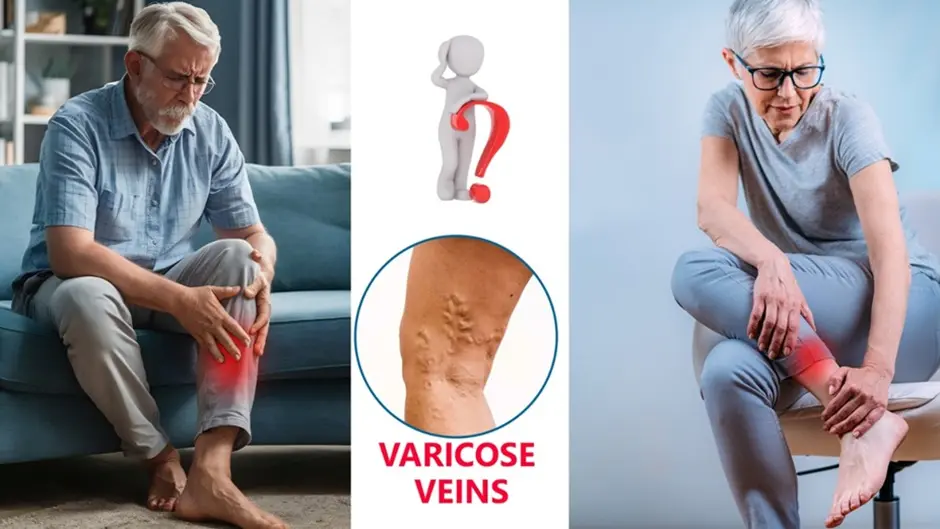Varicose veins are a common vascular condition affecting millions worldwide. This condition is marked by twisted, enlarged veins that are palpable and seen just under the skin. Varicose veins occur due to blood accumulation in the veins and have genetics, hormones, obesity and lifestyle and the chief influencing factors. So that brings us to the question, are varicose veins more common in women than men.
Research studies suggest that the prevalence of varicose veins is higher in women than in men. Factors such as hormonal fluctuations, obesity and lifestyle choices are considered responsible for these numbers.
This article details why varicose veins are more common in women than in men, how each of the factors is responsible for venous insufficiency and how women can protect themselves from developing this condition.

Varicose veins are twisted or bulged veins that can occur in legs, feet, genitals, rectum and anus though they are common in the lower leg area. In many cases, varicose veins may just be of cosmetic concern. However, it is also associated with a host of symptoms which can get debilitation in nature if the condition is neglected.
Venous insufficiency is the contributing factor to the development of varicose veins. Veins are a part of the body’s circulatory system along with arteries and blood capillaries. Veins send deoxygenated blood to the heart. From the heart, blood gets oxygenated and goes back to various parts of the body.
Veins function in pushing back blood to the heart with the help of one-way valves, which prevent the backward flow of blood. The inner walls of the vein function in tandem with the vein valves to ensure blood circulation in the right direction.
Dysfunction of the vein valves or walls or both may hamper blood circulation leading to blood pooling in the veins. This results in swelling of the vein and inflammation leading to a host of symptoms such as pain, discomfort and heaviness.
Lack of blood circulation in the affected veins results in blood leak and tissue damage in the surrounding areas, further worsening the symptoms and adding additional symptoms such as skin hardening, discolouration and irritation.
Long term untreated varicose veins can lead to the development of venous ulcers, which can take many weeks to heal. Deep vein thrombosis of DVT is another complication of long-standing varicose veins, which need immediate medical intervention and may turn life threatening in the absence of emergency medical intervention.
Varicose veins may develop through sedentary lifestyle or carry forward through heredity and also affected by hormonal fluctuations.
Varicose veins are common in older people due to loss of vein elasticity and reduction in valve functioning.
Excess body weight can put pressure on the blood vessels and force them to work harder resulting in venous insufficiency.
Women are at a higher risk of developing varicose veins than men due to hormonal fluctuations that are common during menstruation, pregnancy and menopause
Family history of venous insufficiency increases the chances of developing varicose veins as factors such as vein health are hereditary.
Standing or sitting in the same position for long hours can cause blood to pool up in the veins, increasing the chance of varicose vei
Varicose veins most commonly affect the legs, ankles and fee,t and the symptoms are also likely to occur frequently in the legs, though other parts of the body can get affected too.
Legs are the common site for varicose veins since the veins and vein valves in the lower extremities of the body have to work harder and push against gravity to pump blood to the heart.
The common varicose vein symptoms that occur in the affected area include
• Visible or palpable veins
• Twisted or inflamed veins
• Pain, heaviness and discomfort
• Pain that worsens after prolonged standing or sitting
• Redness, itching or irritation
• Skin hardening or discolouration
• Cramping
• Restless legs
• Ulceration
If you notice these symptoms, you may need to consult with a varicose vein expert who will do a physical examination, run tests as needed and provide remedies and treatment options.
Inflammation is the human body’s response to illnesses, injuries or foreign invaders such as bacteria or viruses. When the body suspects a threat or a foreign invasion, it immediately triggers the body’s defense mechanism. In this process, the source of threat or damage may be eliminated while the body moves towards healing.
The best example of a body’s immune response is a simple fever, which may happen during a bacterial or viral infection. When the body suspects a foreign threat in the form of bacteria or a virus, it may trigger the immune system.
In this process, the body raises its temperature to fight off the pathogens, which may cause symptoms such as fever, chills and fatigue.
Inflammation is short term and usually resolves once the threat has disappeared. Chronic inflammation, however, occurs when the body’s immune inflammatory response continues for weeks or months.
The body may continue to trigger its defense mechanisms and continue to send inflammatory responses even in the absence of a threat, which can lead to chronic inflammation.
Chronic inflammation may start small, develop gradually and persist in the body for months, even years without showing any palpable symptoms, especially in the initial stages/
The symptoms of chronic inflammation include:
• Chronic fatigue
• Joint pains and stiffness
• Muscle and body aches
• Frequent infections
• Excessive or quick weight gain or weight loss
• Mood disorders such as brain fog and depression
• Digestive disorders such as constipation, diarrhea and bloating
The most common causes of chronic inflammation include?
• Persistent or recurring infections
• Obesity and poor lifestyle choices
• Poor sleep hygiene
• Autoimmune disorders
• Regular exposure to toxins and pollution
• Smoking and drinking
Chronic inflammation is also associated with metabolic disorders such as diabetes and hypertension. If left unaddressed, it can lead to serious health complications.
Chronic inflammation can have many negative effects on the health and effective functioning of blood vessels.
Long term inflammatory reactions may lead to the damage of collagen and elastin, two components that are vital for strength and elasticity of arteries and veins. This can hamper the functioning and efficiency of blood vessels in pumping blood.
Chronic inflammation also promotes oxidative stress which may affect endothelial cells or the cells lining the inner walls of blood vessels. Oxidative stress is also known to worsen diseases related to the vascular system such as atherosclerosis and hypertension.
Chronic inflammation can also encourage clot formation by promoting procoagulant factors and inhibiting the natural anticoagulant pathways.
Recent studies suggest that chronic inflammation may contribute to the development and progression of varicose veins.
Varicose veins occur due to venous insufficiency where the veins are unable to pump deoxygenated blood to the heart due to damaged vein walls or valves.
Chronic inflammation can contribute to varicose veins in the following ways
Chronic inflammation can cause the breakdown of two proteins - collagen and elastin - that are responsible for providing strength and elasticity to the vein walls.
Breakdown of these proteins due to chronic inflammation can cause the vein walls to weaken, resulting in blood pooling up leading to varicose veins.
Chronic inflammation can cause damage to vein valves that ensure the blood flow back to the heart.
When the vein valves get damaged, blood may be unable to flow back to the heart and gets accumulated, leading to venous insufficiency and varicose veins.
Endothelial cells line the inner wall of the veins and are responsible for vein health and functioning.
Chronic inflammation can damage these cells. As a result, the vein may not be able to constrict and dilate properly leading to blood accumulation in the veins.
Chronic inflammation may increase the permeability of veins. This allows fluid to leak into the surrounding areas, resulting in water retentio,n which can further worsen varicose vein symptoms.
It is now clear that varicose veins can be caused by chronic inflammation. People with inflammatory diseases, especially those related to the heart and vascular system, may be at a higher risk for developing varicose veins.
So, what can be done to reduce the occurrence and severity of varicose veins in such situations?
Anti-inflammatory interventions are the way to go for varicose veins occurring due to chronic inflammation.
Adoption of anti-inflammatory strategies can help prevent and manage varicose veins.
Here are some anti-inflammatory strategies for varicose veins.
Include anti-inflammatory foods in your diet. The diet should consist of anti-inflammatory foods such as citrus, berries and green leafy vegetables, nuts and seeds, olive oil, omega-3 rich foods such as fish and spices such as turmeric and ginger.
Avoid processed foods, foods high in salt and sugar, canned foods, deep fried foods and refined foods.
Since chronic inflammation is a lifestyle disease, incorporating exercise and mobility into everyday routine can help reduce it. Sedentary lifestyle and prolonged standing and sitting can promote chronic inflammation.
Low impact exercises such as walking and jogging, and yoga can be helpful in promoting blood circulation and reducing varicose vein symptoms.
Wearing compression stockings may help reduce inflammation, improve blood circulation and reduce pain and discomfort.
Addressing the underlying causes for chronic inflammation may help prevent varicose veins. If you suspect chronic inflammation based on symptoms, you may need to see a medical expert who may run tests to detect the root cause for the inflammation. Early detection and medical intervention for varicose veins is also equally important. A varicose vein expert will do a physical examination, run tests as needed and provide a treatment plan.
Varicose veins can be caused by chronic inflammation. Factors such as obesity, poor lifestyle choices and prolonged standing or sitting act as underlying causes for both the conditions.
For cases where chronic inflammation is the causative factor for varicose veins, addressing or treating the inflammation may resolve varicose veins too.
Timely medical intervention is vital for both chronic inflammation and varicose veins, especially where both the conditions are interlinked, to avoid further damage and worsening of the conditions.on.

Yes, chronic inflammation can cause varicose veins. Chronic inflammation can cause damage to vein walls, valves and endothelial cells that can worsen existing varicose veins or cause the formation of new varicose veins.
The root cause of varicose veins is valve damage. Vein valves responsible for one way pumping of blood back to the heart may get damaged, resulting in blood pooling up in the vein which can lead to varicose veins.
Varicose veins are not an autoimmune condition. An autoimmune condition occurs when the body’s defense mechanism mistakes a body organ for a foreign invader and attacks it. Chronic inflammation is one of the manifestations of autoimmune diseases and varicose veins. However, varicose veins occur due to a failed vein valve or endothelial cells lining the vein wall.
Healthy lifestyle changes such as a balanced nutritious diet, exercising, weight management and avoiding a sedentary lifestyle can prevent varicose veins from forming. Leg elevation, using compression stockings, leg elevation, and medical intervention can help prevent further worsening of the condition.
Women are more prone to varicose veins due to hormonal fluctuations that occur during menstruation, pregnancy and menopause. Increased levels of progesterone can cause vein walls to relax and weaken, resulting in varicose vein formation. Elderly people are also at a higher risk due to old age weakening vein valves and walls.